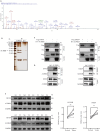[High expression of AURKB promotes malignant phenotype of osteosarcoma cells by activating nuclear factor-κB signaling via DHX9]
- PMID: 39725619
- PMCID: PMC11683349
- DOI: 10.12122/j.issn.1673-4254.2024.12.06
[High expression of AURKB promotes malignant phenotype of osteosarcoma cells by activating nuclear factor-κB signaling via DHX9]
Abstract
Objectives: To investigate the regulatory mechanism of aurora kinase B (AURKB) for promoting malignant phenotype of osteosarcoma cells.
Methods: HA-Vector or HA-AURKB was transfected in 293T cells to identify the molecules interacting with AURKB using immunoprecipitation combined with liquid chromatography-tandem mass spectrometry followed by verification with co-immunoprecipitation and Western blotting. In cultured osteosarcoma cells with lentivirus-mediated RNA interference of AURKB or DHX9 or their overexpression, the changes in cell proliferation, migration, and invasion activities were observed with EDU and Transwell assays. Mechanistic analysis was performed using Co-IP and in vivo ubiquitination experiments to detect the interaction between AURKB and DHX9 and the phosphorylation and ubiquitination levels of DHX9. Western blotting was used to detect the effect of AURKB and DHX9 on activation of nuclear factor-κB (NF-κB) signaling.
Results: AURKB was highly expressed in osteosarcoma cell lines, and in osteosarcoma 143B cells, AURKB silencing significantly reduced cell proliferation, migration and invasion abilities. Interactions between AURKB and DHX9 were detected, and they were both highly expressed in osteosarcoma tissues; silencing AURKB reduced the protein expression of DHX9, and AURKB overexpression increased DHX9 phosphorylation. Silencing AURKB did not significantly affect the transcription and translation of DHX9 but accelerated its degradation and ubiquitination. Overexpression of DHX9 effectively reversed the effects of AURKB silencing on IKBα protein and phosphorylated p65, promoted nuclear translocation of p65 to activate the NF-κB signaling pathway, and enhanced the proliferation, migration, and invasion abilities of cultured osteosarcoma cells.
Conclusions: AURKB overexpression promotes the malignant phenotype of osteosarcoma cells by activating the NF-κB signaling pathway via regulating DHX9.
目的: 探讨AURKB在促进骨肉瘤细胞恶性表型中的具体调控机制。方法: 分别转染HA-Vector和HA-AURKB于293T细胞中,采用免疫沉淀结合液相色谱-串联质谱技术筛选AURKB的潜在互作分子,免疫共沉淀和Western blotting验证其互作分子。通过RNA干扰技术,干扰骨肉瘤细胞中AURKB的表达;设置对照组:转染对照组慢病毒143B细胞,sh-AURKB组:转染干扰AURKB慢病毒143B细胞,sh-con+Flag-DHX9组:对照组转染过表达DHX9慢病毒,sh-AURKB+Flag-DHX9组:沉默AURKB组转染过表达DHX9慢病毒。采用EDU、Transwell实验分别观测细胞的增殖、迁移和侵袭活性。机制分析采用Co-IP、体内泛素化实验等检测AURKB和DHX9的相互作用、DHX9磷酸化水平、DHX9泛素化水平。Western blotting检测AURKB及DHX9对NF-κB的信号激活作用。结果: AURKB在骨肉瘤细胞系高表达。沉默骨肉瘤143B细胞中AURKB的表达,细胞增殖、迁移和侵袭能力下降(P<0.05)。而AURKB与DHX9存在相互作用,且AURKB及DHX9在骨肉瘤组织中均高表达,沉默AURKB能够降低DHX9的蛋白表达,过表达AURKB后DHX9磷酸化水平升高(P<0.05)。沉默AURKB后不影响DHX9的转录翻译,但可以加快DHX9降解速度及增加DHX9泛素化水平。此外,过表达DHX9可以逆转沉默AURKB对IKBα蛋白及磷酸化p65的影响,促进p65入核激活NF-κB信号通路,并且增强了骨肉瘤细胞增殖、迁移和侵袭能力。结论: AURKB通过调控DHX9激活NF-κB信号通路,促进骨肉瘤细胞恶性表型。.
Keywords: DHX9; aurora kinase B; osteosarcoma; phosphorylation.
Figures




Similar articles
-
Potential Molecular Mechanisms of AURKB in the Oncogenesis and Progression of Osteosarcoma Cells: A Label-Free Quantitative Proteomics Analysis.Technol Cancer Res Treat. 2018 Jan-Dec;18:1533033819853262. doi: 10.1177/1533033819853262. Technol Cancer Res Treat. 2018. Retraction in: Technol Cancer Res Treat. 2025 Jan-Dec;24:15330338251321913. doi: 10.1177/15330338251321913. PMID: 31122179 Free PMC article. Retracted.
-
AURKB targets DHX9 to promote hepatocellular carcinoma progression via PI3K/AKT/mTOR pathway.Mol Carcinog. 2024 Sep;63(9):1814-1826. doi: 10.1002/mc.23775. Epub 2024 Jun 14. Mol Carcinog. 2024. PMID: 38874176
-
Knockdown of Aurora-B alters osteosarcoma cell malignant phenotype via decreasing phosphorylation of VCP and NF-κB signaling.Tumour Biol. 2015 May;36(5):3895-902. doi: 10.1007/s13277-014-3032-4. Epub 2015 Jan 21. Tumour Biol. 2015. PMID: 25874486
-
Knockdown of Aurora-B inhibits osteosarcoma cell invasion and migration via modulating PI3K/Akt/NF-κB signaling pathway.Int J Clin Exp Pathol. 2014 Jun 15;7(7):3984-91. eCollection 2014. Int J Clin Exp Pathol. 2014. PMID: 25120775 Free PMC article.
-
NF-κB signaling and the tumor microenvironment in osteosarcoma: implications for immune evasion and therapeutic resistance.Front Immunol. 2025 Jan 30;16:1518664. doi: 10.3389/fimmu.2025.1518664. eCollection 2025. Front Immunol. 2025. PMID: 39949765 Free PMC article. Review.
Cited by
-
Exploratory Analysis of Molecular Subtypes in Early-Stage Osteosarcoma: Identifying Resistance and Optimizing Therapy.Cancers (Basel). 2025 May 16;17(10):1677. doi: 10.3390/cancers17101677. Cancers (Basel). 2025. PMID: 40427174 Free PMC article.
References
-
- Friebele JC, Peck J, Pan XL, et al. . Osteosarcoma: a meta-analysis and review of the literature[J]. Am J Orthop, 2015, 44(12): 547-53. - PubMed
-
- Gill J, Ahluwalia MK, Geller D, et al. . New targets and approaches in osteosarcoma[J]. Pharmacol Ther, 2013, 137(1): 89-99. - PubMed
-
- Chen YQ, Liu RZ, Wang W, et al. . Advances in targeted therapy for osteosarcoma based on molecular classification[J]. Pharmacol Res, 2021, 169: 105684. - PubMed
Publication types
MeSH terms
Substances
LinkOut - more resources
Full Text Sources
Miscellaneous
